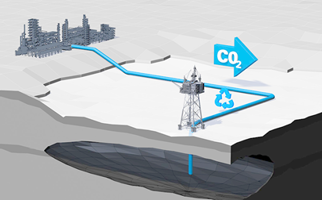
-
Regulator honoured with three awards in space of a few momentous weeks
-
Digital Energy Platform empowers organisations from different sectors to carry out spatial mapping and unlock value of data
-
NSTA makes more data available to more people than ever before
The North Sea Transition Authority (NSTA) proudly scooped up a trio of prestigious awards last month in a ringing endorsement of its leadership and delivery in data and digital.
The regulator was one of only three UK companies to receive a coveted Special Achievement in GIS Award at the annual User Conference of software developer ESRI in San Diego, California.
ESRI recognised the NSTA for its application of spatial planning and digital solutions to help plan and deliver a holistic, interconnected energy system in the UK Continental Shelf (UKCS). This is key to accelerating the UK’s transition to net zero, cutting emissions and supporting energy security – the NSTA’s three priorities.
The award is only presented to the best organisations using GIS (geographic information systems). The NSTA was among 200 global winners, out of nearly 700,000 ESRI users, which put us in the top 0.03% of organisations last year.
The NSTA also bagged a brace of prizes at the Computing UK Digital Technology Leader Awards in London – among them, the gong for Best Public Sector Digital Project for the Digital Energy Platform, while the NSTA’s John Seabourn was named Chief Digital Officer of the Year.
The Digital Energy Platform boasts a selection of impressive tools, including the National Data Repository (NDR), open data site, data and insights centre and Energy Portal, which have transformed the availability of accessible data.
Through the platform, organisations can undertake spatial and subsurface mapping to accommodate and integrate a range of technologies offshore – such as carbon storage, hydrogen, wind and oil and gas – and unlock the value of data.
The NDR holds more than one petabyte of free information gleaned from more than 60 years of activity. Originally set up to support the oil and gas industry, it is increasingly used by companies, academics and individuals working in carbon storage, offshore wind and hydrogen.
These datasets have made an important contribution to accelerating the energy transition. Seismic processing company Rockwave used legacy oil and gas data from the NDR to help applicants make successful bids for ScotWind leases.
In addition, the NDR’s subsurface data supported applications for carbon storage licences – on the day that the NSTA launched the UK’s first ever carbon storage round, NDR data downloads increased 20-fold.
The NSTA applies data to continuously develop its understanding of future potential areas for carbon dioxide and hydrogen storage in support of delivering government ambitions.
Furthermore, high-quality data underpins the NSTA’s work to track and benchmark oil and gas operators’ efforts to reduce production emissions. And it supported our screening of opportunities to repurpose oil and gas infrastructure for the energy transition. Our analysis showed reusing pipelines for carbon dioxide and hydrogen storage could save operators around £7bn.

Nic Granger, Director of Corporate at the NSTA, said: “Winning an award is a great privilege, but to lift three in just a few weeks is truly special and I am tremendously proud of our team. It speaks volumes for the terrific work they do with our partners to accelerate the energy transition by designing game changing digital tools and making large volumes of valuable data available at the click of a button.”
For further information please contact:
Tel: 07776 548196


